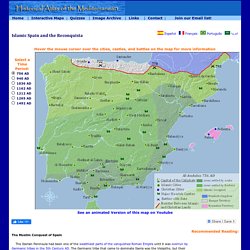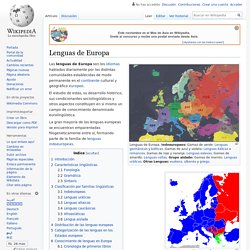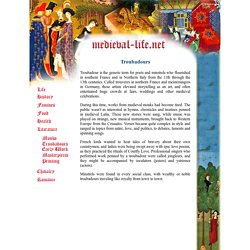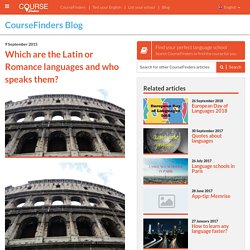

Tribes Invade Europe. Table of Contents : The beginnings In the year 476 A.D. the Roman Empire came to an end and the next thousand years were called the Middle Ages.

Life in Europe during the Middle Ages was very hard. Only a few people could read and write. The only hope for people was their religion. Language. Languages change over time.

Just ask an older person about the slang they used as a child and compare it to the slang you use. In medieval England, they spoke a version of English called Old English or Anglo-Saxon. Although Old English is at the root of modern English, when you write it down, it does not look like the English we speak today. In fact, it looks something like this: oðþæt him æghwylc þær ymbsittendra ofer hronrade hyran scolde (Beowulf, Old English). Anglo-Saxon uses only some of the same letters we use in our alphabet today. The Fall of the Roman Empire. The Roman Empire began to slowly decline in the 3rd century AD, one of the main causes of Rome's early decline was a series of plagues, most notably the Plague of Cyprian, which decimated the population of the Empire, making it harder for Roman Emperors to levy armies and raise taxes.

Diocletian became Emperor in 284 AD, he saw the vast empire as ungovernable and split it in half, creating two equal emperors to rule each. Under various subsequent rulers, the Eastern and Western Roman Empire were reunited into a single entity. Islamic Spain and the Reconquista. The Muslim Conquest of Spain The Iberian Peninsula had been one of the wealthiest parts of the vanquished Roman Empire until it was overrun by Germanic tribes in the 5th Century AD.

The Germanic tribe that came to dominate Iberia was the Visigoths, but their reign would be short. In 711 AD, the Arabs began an invasion of Iberia under the leadership of Tariq Ibn Ziyad. Tariq landed at Gibraltar (in fact Gibraltar is a corruption of the Arabic 'Gibr Tariq': the rock of Tariq) and conquered virtually the entire peninsula in a 7 year campaign. Where did English come from? - Claire Bowern. There are two other TED-Ed lessons related to this topic: How languages evolve and How did English evolve?

(a lesson that fills in some of the details that we omit here due to the fact that the focus of this lesson was further in the past). There is still a great deal of debate about Indo-European, most importantly about the location of the homeland. To read more about this debate, there are classic books by Mallory and Renfrew, as well more recent works by Anthony. Then, read these articles by Bouckaert et al. At the same site, watch this movie that shows one hypothesis about how Indo-European languages expanded.
A Medieval textbook. Interactive from the Fitzwilliam museum: manuscript_5a. Listening to the Medieval book. ARABIC Influence on Spanish & Portuguese! Lenguas de Europa. Las lenguas de Europa son los idiomas hablados diariamente por las distintas comunidades establecidas de modo permanente en el continente cultural y geográfico europeo.

El estudio de estas, su desarrollo histórico, sus condicionantes sociolingüísticos y otros aspectos constituyen en sí mismo un campo de conocimiento denominado eurolingüística. La gran mayoría de las lenguas europeas se encuentran emparentadas filogenéticamente entre sí, formando parte de la familia de lenguas indoeuropeas. Introducción[editar] La gran mayoría de lenguas de Europa cuentan con algún estándar escrito o literario reconocido por la mayoría de sus hablantes. Esto contrasta ampliamente con la situación entre las lenguas autóctonas de África, América, Oceanía y un número importante de lenguas de Asia, que no tienen una ortografía estandarizada ni son usualmente usadas en el registro escrito. Características lingüísticas[editar] Desde hace siglos Europa es el continente menos diverso lingüísticamente del mundo. Troubadours. Troubadours Troubadour is the generic term for poets and minstrels who flourished in southern France and in Northern Italy from the 11th through the 13th centuries.

Called trouveres in northern France and meistersingers in Germany, these artists elevated storytelling as an art, and often entertained huge crowds at fairs, weddings and other medieval celebrations. During this time, works from medieval monks had become tired. The public wasn't as interested in hymns, chronicles and treatises penned in medieval Latin.
These new stories were sang, while music was played on strange, new musical instruments, brought back to Western Europe from the Crusades. French lords wanted to hear tales of bravery about their own countrymen, and ladies were being swept away with epic love poems, as they practiced the rituals of Courtly Love. Minstrels were found in every social class, with wealthy or noble troubadours traveling like royalty from town to town. EUSKARA MUNDUAN; BESTEEN AHOTAN Trailer Ofiziala / Official Trailer. Untitled. C4: Comunication. Communications. Organization: Alexa Crawls Starting in 1996, Alexa Internet has been donating their crawl data to the Internet Archive.

Flowing in every day, these data are added to the Wayback Machine after an embargo period. this data is currently not publicly accessible. During the Middle Ages, there was no television, no telephone, and no postal service. If you wanted to talk to someone who was far away, you had to write them a letter and send it by private messenger. This worked well for sending messages between the members of nobility who were taught to read and write and could afford to hire a messenger. References: Sobol, David. Basque - A Language of Mystery. Which are the Latin or Romance languages and who speaks them?
The Latin or Romance languages are also known as Romanic languages.

They are the modern languages which developed from spoken Latin somewhere around the 7th century AD in southern and western Europe. The Latin or Romance languages include Spanish, French, Italian, Portuguese, and Romanian. There are currently about 330 million native-first-language Spanish speakers in the world, 76 million native French speakers, 64 million native Italian speakers, 200 million native Portuguese speakers, and 25 million native Romanian speakers. The Romance Languages and What Makes Them Amazing. Latin and Its Indo-European Language Family. Books and the dissemination of knowledge in medieval Europe. Making Manuscripts.